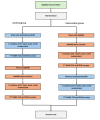Investigating Information Visualization to Combat Information Overload in Electronic Health Records: Protocol for a Randomized Controlled Trial
- PMID: 40925597
- PMCID: PMC12457862
- DOI: 10.2196/74247
Investigating Information Visualization to Combat Information Overload in Electronic Health Records: Protocol for a Randomized Controlled Trial
Abstract
Background: Electronic health records (EHRs) have been linked to information overload, which can lead to cognitive fatigue, a precursor to burnout. This can cause health care providers to miss critical information and make clinical errors, leading to delays in care delivery. This challenge is particularly pronounced in medical intensive care units (ICUs), where patients are critically ill and their EHRs contain extensive and complex data.
Objective: We propose to study the effect of an information visualization dashboard on ICU providers' cognitive fatigue in 4 major US medical centers. In this randomized controlled trial, we will compare 2 leading EHRs with a visualization dashboard-based EHR called AWARE.
Methods: This crossover randomized trial will collect physiological and objective data using a screen-mounted eye-tracking device to assess cognitive fatigue among ICU providers. The study will involve 120 ICU providers from 4 US medical centers, with each site using its institutional EHR as the control and the AWARE EHR as the intervention. Participants will be randomly assigned to use either their institutional EHR or the AWARE EHR first, followed by the other EHR, with the order of EHR use and patient case order randomized by the study team. The AWARE tool is designed to integrate within an existing EHR system and provides clinical support tools, such as the ability to trend data points from body systems at a glance. Data analysis will include eye-tracking metrics, performance measures, and validated surveys to evaluate EHR usability and its impact on clinical decision-making. Primary outcomes include the number of cognitive fatigue instances per patient case, time to complete each case, overall usability of the session, number of mouse clicks per case, provider performance scores from questions asked during each patient case, and perceived usability of each EHR. Secondary outcomes include the number of eye fixations per patient case and perceived workload of each EHR.
Results: This EHR usability study was funded in 2021 and initiated in 2022, with a completion date of 2025. Data collection began in August 2023. As of now, 3 of the 4 study sites have completed data collection, with a total of 113 completed sessions thus far. Data collection is ongoing at the fourth site. Preliminary analysis is ongoing, and we expect to begin publishing results in late 2025.
Conclusions: Findings from this research may inform improvements in EHR interface design and usability, which may enhance provider performance, streamline care delivery, and improve patient safety outcomes.
Trial registration: ClinicalTrials.gov NCT05937646; https://clinicaltrials.gov/study/NCT05937646.
International registered report identifier (irrid): DERR1-10.2196/74247.
Keywords: EHR usability; electronic health records; eye-tracking; information overload; information visualization, cognitive fatigue.
©Saif Khairat, Jennifer Morelli, Marcella H Boynton, Thomas Bice, Jeffrey A Gold, Shannon S Carson. Originally published in JMIR Research Protocols (https://www.researchprotocols.org), 09.09.2025.
Conflict of interest statement
Conflicts of Interest: None declared.
Figures




References
-
- Nijor S, Rallis G, Lad N, Gokcen E. Patient safety issues from information overload in electronic medical records. J Patient Saf. 2022 Sep 01;18(6):e999–e1003. doi: 10.1097/PTS.0000000000001002. https://europepmc.org/abstract/MED/35985047 01209203-202209000-00034 - DOI - PMC - PubMed
-
- Roetzel PG. Information overload in the information age: a review of the literature from business administration, business psychology, and related disciplines with a bibliometric approach and framework development. Bus Res. 2018 Jul 06;12(2):479–522. doi: 10.1007/s40685-018-0069-z. - DOI
-
- Singh H, Spitzmueller C, Petersen NJ, Sawhney MK, Sittig DF. Information overload and missed test results in electronic health record-based settings. JAMA Intern Med. 2013 Apr 22;173(8):702–4. doi: 10.1001/2013.jamainternmed.61. https://europepmc.org/abstract/MED/23460235 1657753 - DOI - PMC - PubMed
-
- Arnold M, Goldschmitt M, Rigotti T. Dealing with information overload: a comprehensive review. Front Psychol. 2023;14:1122200. doi: 10.3389/fpsyg.2023.1122200. https://europepmc.org/abstract/MED/37416535 - DOI - PMC - PubMed
Publication types
MeSH terms
Associated data
LinkOut - more resources
Full Text Sources
Medical
Research Materials

